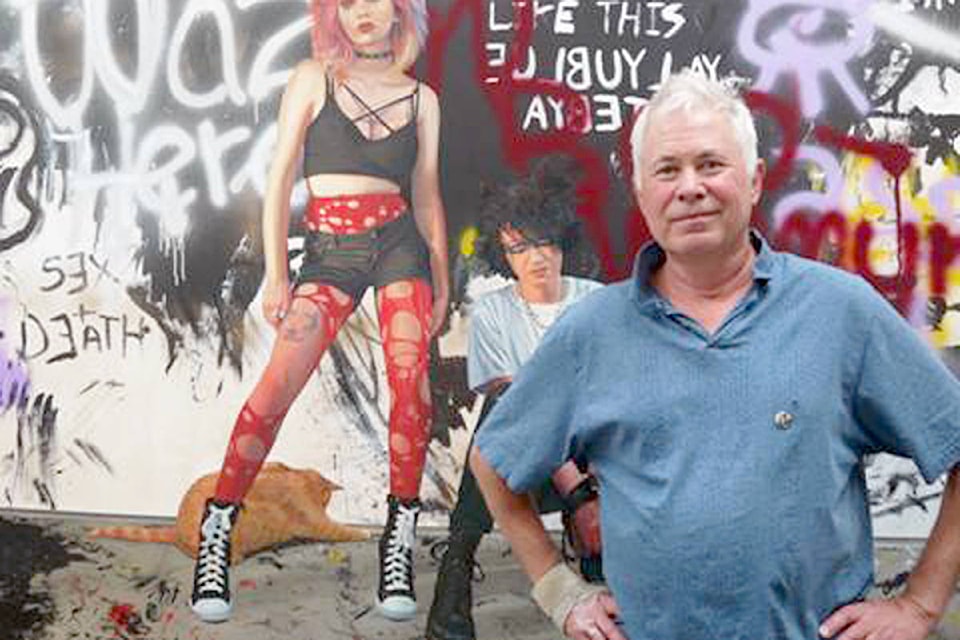Julie Oakes
Special to The Morning Star
Glenn Clark’s exhibition Wackem Sackem at Headbones Gallery in 2015 brought viewers through the doors from walks of life not usually interested in art because the popular appeal of his subject matter touched a resonant chord.
In this current iteration, Giddieeyup promises to engage with an equal punch. Clark will be in attendance at the opening reception on Oct. 5 from 6-8 p.m.
Ruby Blues, where “Catch your Dream” rides the lintel of the winery door and “the tasting fee is a smile” will cater the evening, an apt pairing for Clark has caught his dreams in paint.
Clark is a realist because his style is such but his subjects — and this is where the artist holds absolute sway — appear outside of reality. Even an old car rusting in a field carries more of the aura of the past, an implied story, than a sensation of immediate presence. The cars have been overtaken by the artist, claimed for a storyboard that has now become specific in another, more auspices way than that which makes up virtual reality. There is a strange vermillion cast on the front hood of the old Pontiac eight. The bloody cast seems to creep forwards and out of the frame as the tail of another car, the exact same suggestive hue occupies the foreground like a rumbling wave — not lost and forgotten but found and refreshed.
Clark deals with time masterfully. Clark saw Gustave Courbet’s painting Girls on the Banks of the Seine and “it blew my socks off,” he says. Courbet’s detail is not stultified but liquid, the figures relaxed, their physical being in tune with nature so that even the intricate patterning of the dresses feels endemic to the scene.
With an eye for treasures, Clark came across his mother’s wedding dress and knew that he had to make a painting based on Courbet’s Girls. Clark has girls of his own an as a contemporary man, seated in the surrounds of family and the stuff of this age he lifted the idea of the melding conversation between beautiful young women in their physical prime and a natural setting. Using the wedding dress, his daughter and her friend posed for him and Clark struck as a chord as resonant with authenticity as Courbet’s work. By assuming the air of a painter from the nineteenth century through subject matter, Clark’s effect is fresh, eye-opening and rejuvenating.
Clark took another step. He painted the same two women in clothes that reflect their age and interests in a setting as contemporarily urban as it gets. There is the same spirit shining forth but the garb, gear and graffiti impart a new, defiant, almost warrior-like aura to the two women. With a tattoo of a wolf on her thigh and the black eyes of a racoon masking the other, Clark has inserted their brazen beauty into the conversation so that there is no room to consider them flowers-for-the-picking as the Courbet might suggest.
Courbet had relished his gazing position on prone female bodies and sealed his voyeurism with L’Origin du Monde. Clark’s reversed text, Sex and Death, on the wall behind the women affirms the holistic portrait, making contemporary a reference that though well known to art lovers, was censored at the time. L’Origin du Monde hangs in the Louvre, its place and accessibility solidified by time.
Clark is a realist who takes chances with his subject matter as if challenged by enticing sirens who prompt his direction like hostesses whose invitations to dance he accepts just in order to bring about a different translation of a trope secured by time and repetition.
Related: Fun summer nights at Headbones Gallery
The knights on horses that he has rendered over three paintings reference historical portraits and like Tolstoy’s War and Peace they enter an echelon of images based on ideas of battle, protection, aggression, and the gaining of ground. Yet each rendition is awry when examined with more than the cursory glance that often arrives on historical paintings around battle scenes. In Clark’s frame, a mighty bear descends on the scene as if flung from a tornado where blackbirds circle cawing and scree-ing above a man who is bending to see or help a fallen soldier. The concerned figure shows a vulnerable back clothed only in cotton, armour-less but still as faceless as most of the helmeted others as all-action gung-ho hurtles past him. The contrast between the flesh of a fallen man or a wrestling figure whose opponent is nebulous but bares the hind legs of a lion, along with the realistic depictions of dogs reinforce the atmosphere of chaos. Nobody wins here and the smaller blond head that tries to gain the attention of a mounted warrior, despite his size, remains poignant.
Yet there is wonder and innocence in Clark’s work. A demure girl peers cautiously but with interest into an implied abyss. He capitulates marvel as a cat free falls before an old tramcar decorated by a cartoon. Clark is not entirely a realist for his perspective is enchanted despite his willingness to tackle the grand themes.
Not frightened but encouraged to look and question, Clark plays with the message underneath the cacophony of established norms and his response is reflected back at us with just enough room to appreciate. His technical expertise is sure to convince any wary nay-sayer that art is awesome, pertinent and yet way out there from the furthest reaches of an imagination that is accustomed to flying free. Like Clark’s self-portrait, launching ferociously into the air, riding a broomstick like some kind of male witch is true to form. Clark’s potion is bubbling and boiling over with exuberance.
Giddieeyup by Clark is at Headbones Gallery until Nov. 24.
@VernonNews
newstips@vernonmorningstar.com
Like us on Facebook and follow us on Twitter.
